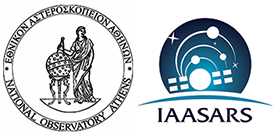Introduction to HESPERIA REleASE+:
HESPERIA REleASE+ combines the existing HESPERIA REleASE system (the relativistic electron module) with a novel radio module that qualifies type-III radio bursts as a precondition for a proton alert with the aim of reducing specific sources of false alarms. Type-III radio bursts, that are produced by electron beams accelerated in solar eruptive events travelling outward through the corona along open magnetic flux tubes, are used as an independent early evidence of particle escape from the Sun. The radio module automatically detects type-III radio bursts from STEREO-A SWAVES real-time radio spectrograms and determines a set of parameters that narrow down detected type-III radio bursts to those that have the potential of causing near-Earth significant solar proton events. HESPERIA REleASE+ issues a proton alert only if the relativistic electron module creates an alert within the forecasting window set by the radio module. HESPERIA REleASE+ switches back to HESPERIA REleASE when data gaps in real-time radio data prevent proper identification of relevant type-III bursts.
HESPERIA REleASE+ has been developed through funding from the National Aeronautics and Space Administration under grant agreement No. TXS0150641A (National Observatory of Athens) and No. TXS0150642 (Christian-Albrechts-Universität) and has been built in the open-source programming language PYTHON.
Posner A., Malandaki O., et al., 2024. HESPERIA REleASE+: Improving Solar Proton Event Forecasting by means of Automated Recognition of Type-III Radio Bursts, Space Weather Journal, 22, e2024SW004013. https://doi.org/10.1029/2024SW004013.
Description of plot:
Both upper row panels show real-time proton fluxes measured by SOHO/EPHIN in the energy ranges of 15.8 to 39.8 MeV (shown in red) and 28.2 to 50.1 MeV (shown in blue). The next three panels show the proton flux forecasts in 30, 60 and 90 minutes (from top to bottom) obtained with the HESPERIA RELEASE forecasting scheme, based on electron measurements by SOHO/EPHIN (left column panels) and ACE/EPAM (right column panels), respectively. All forecasts use the same color code as the real-time proton flux in the top panel. In all forecast panels, vertical dashed blue lines - when present - indicate either the time that a proton alert is first issued by the forecasting system or the time of an updated (12-hour) proton alert within an already ongoing proton event. The fifth-row panels show the respective measured real-time electron fluxes used for the forecasts. The SOHO/EPHIN and ACE/EPAM electron fluxes cover the energy range of 0.25 to 1.0 MeV and 0.175 to 0.315 MeV, respectively. Both bottom panels show the real time STEREO/A SWAVES beacon radio fluxes (in dB) in the frequency range of 0.125 to 16 MHz, that are used for the identification of type-III radio bursts, indicative of particle escape from the Sun, with the potential of causing significant solar proton events (with fluxes surpassing the 0.1 cm-2 s-1 sr-1 MeV-1 threshold value in either proton energy channel). Red rectangles, when present, indicate the forecasting window (FW) set by the radio data, namely the maximum time interval within which a significant proton event is expected to occur after the onset of an associated strong type-III radio burst.At the very bottom of the plots, we indicate if the HESPERIA REleASE+ forecasting system is presently running, or whether we have alternatively switched to HESPERIA REleASE due to the presence of significant gaps in STEREO/A SWAVES data. Thin bars just below the bottom forecast panels indicate whether the corresponding forecasts above have been issued, at corresponding times, from the HESPERIA REleASE+ (orange lines) or the HESPERIA REleASE forecasting system (cyan lines).
Historic Data:
Historic data for HESPERIA REleASE+ can be found from Data Retrieval Tool (DRT).

 hesperia [dot] info [at] hesperia-space [dot] eu
hesperia [dot] info [at] hesperia-space [dot] eu


